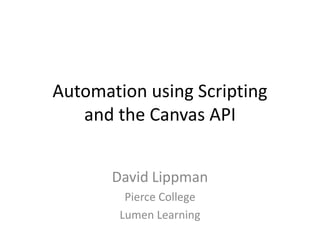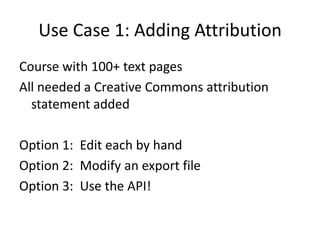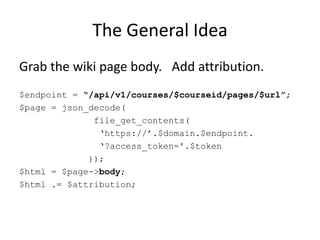Automation using Scripting and the Canvas API
- 1. Automation using Scripting and the Canvas API David Lippman Pierce College Lumen Learning
- 2. Outline ŌĆó Quick overview of the Canvas API ŌĆó Why would we want to use it? ŌĆó Examples of scripting against the API ŌĆó Examples of scripting against export files
- 3. API API = Application Programming Interface A way for other programs to access data or make changes in Canvas courses https://canvas.instructure.com/doc/api/
- 4. API ŌĆ£RESTŌĆØ: Basic GET/PUT/POST HTTP calls JSON format return https://domain.instructure.com/api/v1/courses
- 5. Authentication HTTP Authorization Header Send access token in the query string https://domain.instructure.com/api/v1/courses?access_token=<ACCESS-TOKEN>
- 7. Generating a Token Scroll ╗Õ┤ŪĘ╔▓įŌĆ”
- 11. So where does that get us? or Why should we care?
- 12. Use Case 1: Adding Attribution Course with 100+ text pages All needed a Creative Commons attribution statement added Option 1: Edit each by hand Option 2: Modify an export file Option 3: Use the API!
- 13. The General Idea Call the page list. https://domain.instructure.com/api/v1/courses/12345/pages
- 14. The General Idea Call the page list. Repeat if needed. $endpoint = ŌĆ£/api/v1/courses/$courseid/pages/ŌĆØ; $itemlist = json_decode( file_get_contents( ŌĆ×https://ŌƤ.$domain.$endpoint. ŌĆ×?per_page=50&page=ŌĆ×.$pagecnt. ŌĆ×&access_token=ŌĆ×.$token )); foreach ($itemlist as $item) { $url = $item->url;
- 15. The General Idea Grab the wiki page body.
- 16. The General Idea Grab the wiki page body. Add attribution. $endpoint = ŌĆ£/api/v1/courses/$courseid/pages/$urlŌĆØ; $page = json_decode( file_get_contents( ŌĆ×https://ŌƤ.$domain.$endpoint. ŌĆ×?access_token='.$token )); $html = $page->body; $html .= $attribution;
- 17. The General Idea Send back
- 18. The General Idea Send back using CURL $endpoint = ŌĆ£/api/v1/courses/$courseid/pages/$urlŌĆØ; $ch = curl_init(ŌĆ×https://ŌƤ.$domain.$endpoint. ŌĆ×?access_token=ŌƤ.$token ); curl_setopt($ch, CURLOPT_RETURNTRANSFER, true); curl_setopt($ch, CURLOPT_HEADER, 0); curl_setopt($ch, CURLOPT_SSL_VERIFYPEER, false); curl_setopt($ch, CURLOPT_CUSTOMREQUEST, "PUT"); curl_setopt($ch, CURLOPT_POSTFIELDS, ŌĆ×wiki_page[body]=ŌƤ.urlencode($html)); $response = curl_exec($ch);
- 19. Time to Library-ize require("canvaslib.php"); $api = new CanvasLMS($token,$domain); $pages = $api->getPageList($courseid); foreach ($pages as $id=>$name) { $body = $api->getPageData($courseid, $id, 'body'); $body .= $attribution; $api->updatePage($courseid, $id, array("body"=>$body)); }
- 20. Use Case 2: Assignment Settings Adding Instructions to all Assignments in a course
- 21. Use Case 2: Assignment Settings $assn = $api->getAssignmentList($courseid); foreach ($assn as $id=>$name) { $api->updateAssignment($courseid, $id, array(ŌĆ£descriptionŌĆØ=>$text)); }
- 22. Use Case 3: Fixing links foreach ($pages as $id=>$name) { $body = $api->getPageData($courseid, $id, 'body'); $body = str_replace(ŌĆ£oldsite.comŌĆØ,ŌĆ£newsite.comŌĆØ, $body); $api->updatePage($courseid, $id, array("body"=>$body)); }
- 23. Use Case 4: Removing Links foreach ($pages as $id=>$name) { $body = $api->getPageData($courseid, $id, 'body'); $body = preg_replace( '/<a[^>]*badsite[^>]*>(.*?)</a>/sm', ' $1 ', $body); $api->updatePage($courseid, $id, array("body"=>$body)); }
- 24. Use Case 5: Rehosting Images preg_match_all( ŌĆ×/images.badsite.com[^>]*(gif|png|jpg)/ŌĆ×, $str, $matches); foreach ($matches[0] as $m) { $bn = basename($m); cp(ŌĆ×http://ŌƤ.$m, ŌƤ./imgs/ŌƤ.$bn); $str = str_replace($m, ŌĆ×newhost.com/ŌƤ.$bn, $str); }
- 25. General purpose, web-based tool Append Replace Search-and-replace Regex search-and-replace http://www.imathas.com/canvas/canvassearch.html Alternate Approach
- 26. Working with Exports Upsides: ŌĆó Can be faster for large numbers of pages ŌĆó Can look at changes before uploading Downsides ŌĆó CanŌĆÖt be done on a live class ŌĆó Have to make sense of the file format
- 27. Working with Exports ŌĆó Canvas exports are based on Common Cartridge ŌĆó Exports are renamed zip files ŌĆó Exports contain XML, HTML, and files ŌĆó Main file is imsmanifest.xml ŌĆō <resource> shows type and location of items ŌĆō <item> shows item structure (modules)
- 29. require("phpQuery-onefile.php"); $zip = new ZipArchive; $zip->open($file); phpQuery::newDocumentXML( $zip->getFromName("imsmanifest.xml")); $ref = pq("resource"); foreach ($ref as $r) { $reflist[pq($r)->attr("identifier")] = pq($r)->attr("href"); $reftype[pq($r)->attr("identifier")] = pq($r)->attr("type"); }
- 30. $items = pq(ŌĆ£itemŌĆØ); foreach ($items as $item) { $iref = pq($item)->attr("identifierref"); if (isset($reftype[$iref]) && $reftype[$iref]=="webcontent") { $filename = $reflist[$iref]); $html = $zip->getFromName($filename); $html = str_replace(ŌĆ×</body>ŌƤ, $attribution.ŌƤ</body>ŌƤ, $html); $zip->addFromString($filename, $html); } }
- 31. Sample Code https://github.com/drlippman/canvas-scripts ŌĆó A simple library for doing API calls ŌĆó A sample program using the library ŌĆó The web-based general purpose tool ŌĆó Search-and-replace in a cartridge example
Editor's Notes
- #2: Before we start:Open up Canvas to a course with a few items in itOpen up general search-and-replace tool. Put in course ID and token


















![The General Idea
Send back using CURL
$endpoint = ŌĆ£/api/v1/courses/$courseid/pages/$urlŌĆØ;
$ch = curl_init(ŌĆ×https://ŌƤ.$domain.$endpoint.
ŌĆ×?access_token=ŌƤ.$token );
curl_setopt($ch, CURLOPT_RETURNTRANSFER, true);
curl_setopt($ch, CURLOPT_HEADER, 0);
curl_setopt($ch, CURLOPT_SSL_VERIFYPEER, false);
curl_setopt($ch, CURLOPT_CUSTOMREQUEST, "PUT");
curl_setopt($ch, CURLOPT_POSTFIELDS,
ŌĆ×wiki_page[body]=ŌƤ.urlencode($html));
$response = curl_exec($ch);](https://image.slidesharecdn.com/wacugscripting-140401120551-phpapp02/85/Automation-using-Scripting-and-the-Canvas-API-18-320.jpg)




![Use Case 4: Removing Links
foreach ($pages as $id=>$name) {
$body = $api->getPageData($courseid, $id, 'body');
$body = preg_replace(
'/<a[^>]*badsite[^>]*>(.*?)</a>/sm',
' $1 ', $body);
$api->updatePage($courseid, $id,
array("body"=>$body));
}](https://image.slidesharecdn.com/wacugscripting-140401120551-phpapp02/85/Automation-using-Scripting-and-the-Canvas-API-23-320.jpg)
![Use Case 5: Rehosting Images
preg_match_all(
ŌĆ×/images.badsite.com[^>]*(gif|png|jpg)/ŌĆ×,
$str, $matches);
foreach ($matches[0] as $m) {
$bn = basename($m);
cp(ŌĆ×http://ŌƤ.$m, ŌƤ./imgs/ŌƤ.$bn);
$str = str_replace($m, ŌĆ×newhost.com/ŌƤ.$bn, $str);
}](https://image.slidesharecdn.com/wacugscripting-140401120551-phpapp02/85/Automation-using-Scripting-and-the-Canvas-API-24-320.jpg)




![require("phpQuery-onefile.php");
$zip = new ZipArchive;
$zip->open($file);
phpQuery::newDocumentXML(
$zip->getFromName("imsmanifest.xml"));
$ref = pq("resource");
foreach ($ref as $r) {
$reflist[pq($r)->attr("identifier")] =
pq($r)->attr("href");
$reftype[pq($r)->attr("identifier")] =
pq($r)->attr("type");
}](https://image.slidesharecdn.com/wacugscripting-140401120551-phpapp02/85/Automation-using-Scripting-and-the-Canvas-API-29-320.jpg)
![$items = pq(ŌĆ£itemŌĆØ);
foreach ($items as $item) {
$iref = pq($item)->attr("identifierref");
if (isset($reftype[$iref]) &&
$reftype[$iref]=="webcontent") {
$filename = $reflist[$iref]);
$html = $zip->getFromName($filename);
$html = str_replace(ŌĆ×</body>ŌƤ,
$attribution.ŌƤ</body>ŌƤ, $html);
$zip->addFromString($filename, $html);
}
}](https://image.slidesharecdn.com/wacugscripting-140401120551-phpapp02/85/Automation-using-Scripting-and-the-Canvas-API-30-320.jpg)
